damn high life, that shit sucks. i thought white flies and gnats were bad lol. ive been using mosquito dunks and spinosad in the soil and its all taken care of now. i dont know of those would work for them as well but i dont see why not. and they are both natural controls
-
Happy Birthday ICMag! Been 20 years since Gypsy Nirvana created the forum! We are celebrating with a 4/20 Giveaway and by launching a new Patreon tier called "420club". You can read more here.
-
Important notice: ICMag's T.O.U. has been updated. Please review it here. For your convenience, it is also available in the main forum menu, under 'Quick Links"!
You are using an out of date browser. It may not display this or other websites correctly.
You should upgrade or use an alternative browser.
You should upgrade or use an alternative browser.
8 Plants x 8 Lights. Farmer's New Toys
- Thread starter FlowerFarmer
- Start date
I really hope they are not root aphids.
They are certainly not black or anywhere near the size that HL pictured. They are very very tiny.. like salt granular size and never stop moving. They look white/translucent in color.
I've had thrips, gnats, and mites and these are none of those.
I cant even see them unless I disturb the top of my coco... then I see lots of them scurrying to take cover. I'll try to see if I can get one to stop moving long enough under a scope to count their legs.
I'm going to look into one of those USB scopes that can blow shit up on a computer screens for looking at trichs and what not.
They are certainly not black or anywhere near the size that HL pictured. They are very very tiny.. like salt granular size and never stop moving. They look white/translucent in color.
I've had thrips, gnats, and mites and these are none of those.
I cant even see them unless I disturb the top of my coco... then I see lots of them scurrying to take cover. I'll try to see if I can get one to stop moving long enough under a scope to count their legs.
I'm going to look into one of those USB scopes that can blow shit up on a computer screens for looking at trichs and what not.
Kit Kat
Member
Might be spring tails or thrips? Here's a post I saved previously when I had something like you're describing when I did organic soil and they were spring tails.
http://www.ces.ncsu.edu/depts/ent/notes/Urban/springtails.htm
Edit oops you said they weren't thrips, I apparently can't read.
http://www.ces.ncsu.edu/depts/ent/notes/Urban/springtails.htm
Edit oops you said they weren't thrips, I apparently can't read.
InstantKarma
Member
getting pretty bad on this back plant. Is this what you guys are saying is K def from low humidity in those intense spots?
View Image
That looks like root aphid damage from what I have seen for sure.
Might be spring tails or thrips? Here's a post I saved previously when I had something like you're describing when I did organic soil and they were spring tails.
http://www.ces.ncsu.edu/depts/ent/notes/Urban/springtails.htm
Edit oops you said they weren't thrips, I apparently can't read.
I wondered the same, if they were springtails.. ?
If so, all good

FF, don't know how I ever lost this thread, but I'm back. I'll try to stay out of the way, ..

InstantKarma
Member
Springtails don't seem to continuously cruise around like FF said they were doing, though. From what I've seen, they stay relatively still until they jump to the next place, not a very smooth motion compared to an aphid.I wondered the same, if they were springtails.. ?
If so, all good
FF, don't know how I ever lost this thread, but I'm back. I'll try to stay out of the way, ..
Springtails don't seem to continuously cruise around like FF said they were doing, though. From what I've seen, they stay relatively still until they jump to the next place, not a very smooth motion compared to an aphid.
I've got springtails in my soil, and once you focus in on 'em (tiny little buggers), they definitely creep and crawl around, .. Motion similar to an ant on the sidewalk - just kind of milling about..
Anyway, I'm way late to the conversation, and I didn't mean to assert that they are in fact springtails - just meant that if that's what they are, then there's no need to worry..

Will do.
Not sure what these little things are. Not really touching this room this late in the game. Got about 22 days left...
I do have a question though. I do really regret not cleaning up those those smaller shrubs.. middle one didnt get thinned at all..two others only of easy pulling leaves from within. Is it detrimental to flower swellage to do anything now?
Here are some shots. Finally starting to plump up.
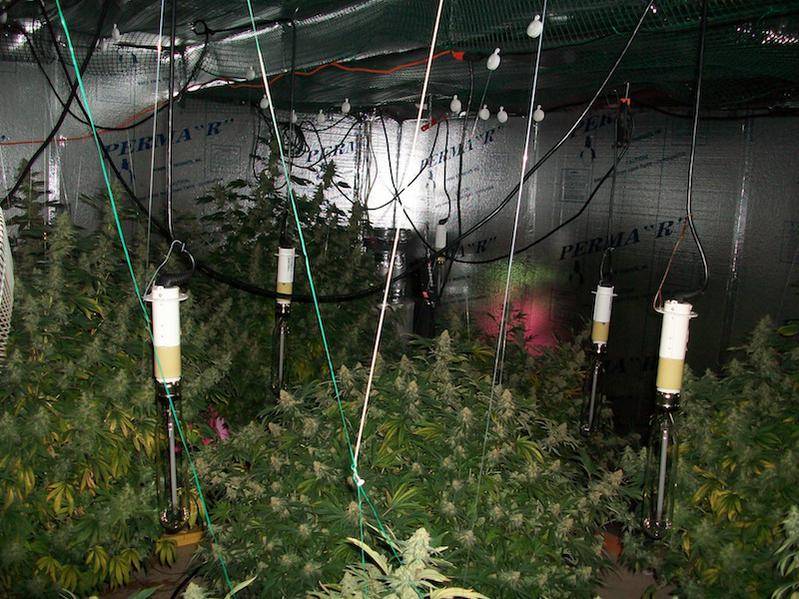
These Lemons always got tall and lanky on me in Horizontal growing. I like them a lot more this way. A few still crept out of the sweet spots, but that meat up right around the bulbs can be pretty deceiving...
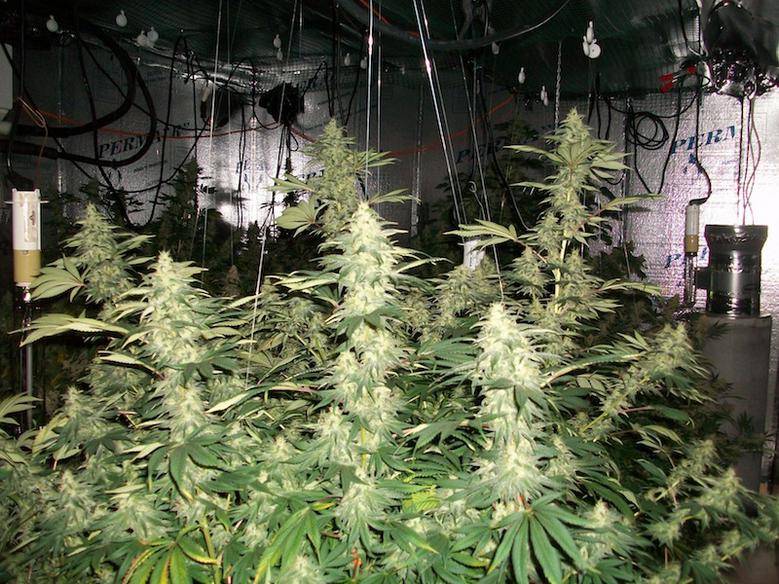
Aerial of the middle meatball - pineapple express. The hairs on this thing are crazy.. almost like a light pink.. really need to get a better cam.
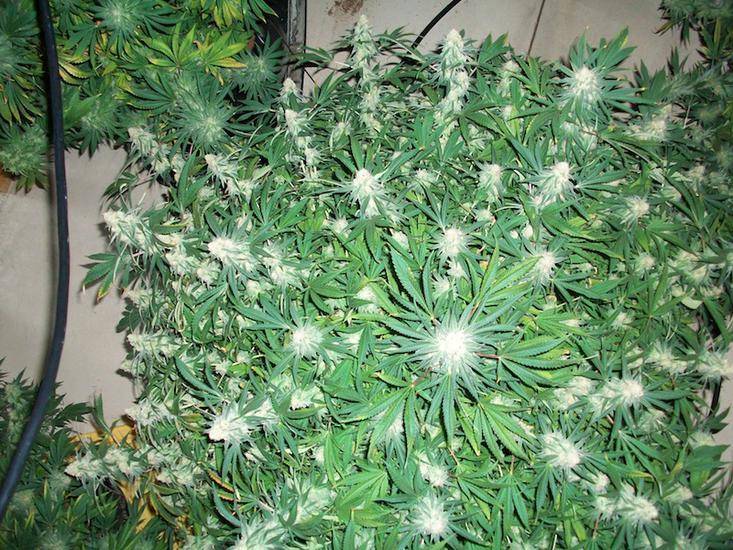
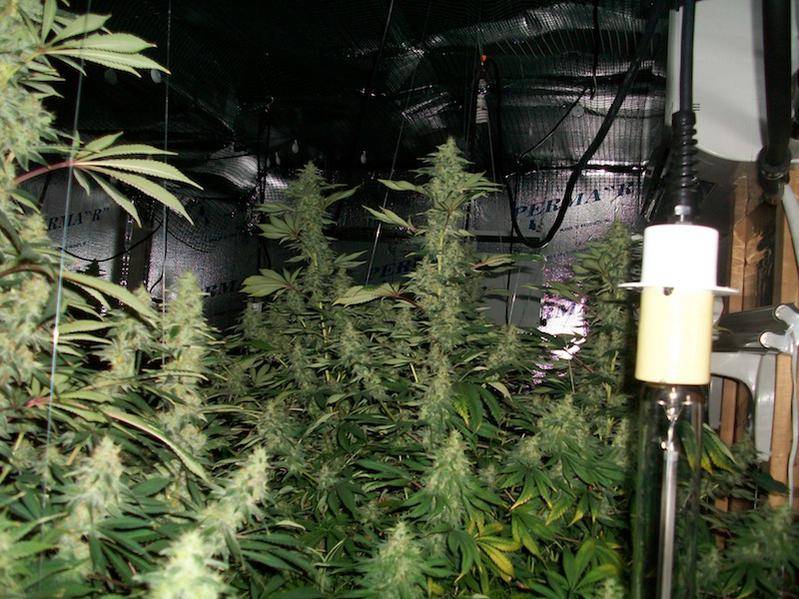
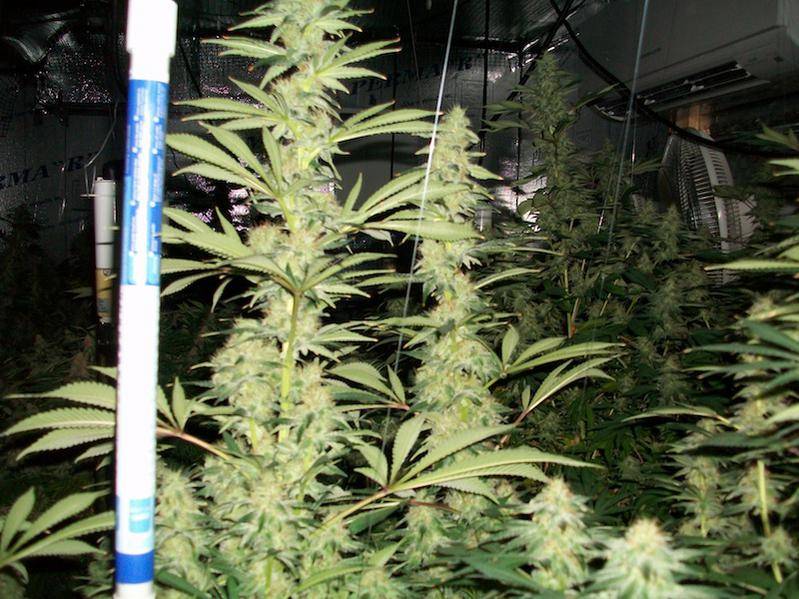
Not sure what these little things are. Not really touching this room this late in the game. Got about 22 days left...
I do have a question though. I do really regret not cleaning up those those smaller shrubs.. middle one didnt get thinned at all..two others only of easy pulling leaves from within. Is it detrimental to flower swellage to do anything now?
Here are some shots. Finally starting to plump up.
These Lemons always got tall and lanky on me in Horizontal growing. I like them a lot more this way. A few still crept out of the sweet spots, but that meat up right around the bulbs can be pretty deceiving...
Aerial of the middle meatball - pineapple express. The hairs on this thing are crazy.. almost like a light pink.. really need to get a better cam.
My ceiling netting is initially stapled to the ceiling to get it up there. Then I went around and secured it with screws and large 2" washers all over the place. Its saggy in places but allows me to reach up and snap a yo-yo onto it.
No harm in removing leaves anytime after stretch is over. I would break it down into two or three leaf removal sessions though. As a general rule of thumb I never remove more than 30% of the total leaf mass I want gone in one session. I prefer to start right after stretch and do about 20% at a time, but it's never too late to start exposing buds to more light 
Garden is looking good flower

Garden is looking good flower


That's a spicy'a meat'abolla!
D
DaveTheNewbie
damn i love this photo
BldSwtTrs
Member
As others have said DEFOLIATE. Mr. D was saying anytime after stretch and I agree. I have always straight up RAPED my gals after stretch and it has significantly increased my yields. This is over thousands of plants...
If taking lots of fans makes you uncomfortable, JackMayOffer suggests taking fans after week 5 and I have to say I had my best harvest ever after following this. Only one harvest done that way though so I am not prepared to say that week 5 is definitely the best time to do it. Have always waited til after stretch though...
If taking lots of fans makes you uncomfortable, JackMayOffer suggests taking fans after week 5 and I have to say I had my best harvest ever after following this. Only one harvest done that way though so I am not prepared to say that week 5 is definitely the best time to do it. Have always waited til after stretch though...
Please don't rip all those energy producers off.
A few large fans blocking lights to lower nodes, or at the end of cycle to prevent mold(ie harvest day pull leafs, and as you harvest the lowers can mature and avoid late cycle humidity)
Touchy subject for sure, but fact is all the bro science in the world doesn't change the fact that if your plants are producing to the max and you strip leafs you will reduce yields.
Grape farmers and cotton farmers know what I'm talking about as both practice defoliation, in grapes fruit sites with corresponding leaf sites defoliated yield less but it helps prevent powdery mildew and botrytis in humid environments. Cotton farmers defoliate after the plants are fully ripe to prevent pests and mold during the harvest, as the cotton stands in the field after ripe until they get to them.
My copper clad deposit, for what it's worth
http://openagricola.nal.usda.gov/Record/IND23224003
http://ainfo.cnptia.embrapa.br/digital/bitstream/item/44655/1/pab158-96.pdf
http://www.actahort.org/books/931/931_42.htm
http://ajevonline.org/content/61/3/372.abstract
http://www.sciencedaily.com/releases/2011/12/111212124553.htm
A few large fans blocking lights to lower nodes, or at the end of cycle to prevent mold(ie harvest day pull leafs, and as you harvest the lowers can mature and avoid late cycle humidity)
Touchy subject for sure, but fact is all the bro science in the world doesn't change the fact that if your plants are producing to the max and you strip leafs you will reduce yields.
Grape farmers and cotton farmers know what I'm talking about as both practice defoliation, in grapes fruit sites with corresponding leaf sites defoliated yield less but it helps prevent powdery mildew and botrytis in humid environments. Cotton farmers defoliate after the plants are fully ripe to prevent pests and mold during the harvest, as the cotton stands in the field after ripe until they get to them.
My copper clad deposit, for what it's worth
http://openagricola.nal.usda.gov/Record/IND23224003
Quantifying the effect of leaf area loss on sunflower (Helianthus annuus L.) yield caused by hail, pests, and diseases is important in the management of this crop, both from a technical and economic point of view. The effect of defoliation depends, however, on the foliar surface eliminated and on the growth stage at which this takes place. This effect has been quantified in the USA, but these data are lacking for specific conditions of Europe. The aim of this paper was to determine the response of sunflower cultivation to several levels of defoliation that took place at different growth stages under European growth conditions. Four field trials were conducted by applying four defoliation treatments (nondefoliated control, 33, 66, and 100%) at different growth stages ranging from preflowering (R2) to physiological maturity (R9). Crop yield loss increased with increasing level of defoliation. Preflowering stage R3 was the most sensitive. At this stage a 100% defoliation of the leaf surface resulted in 92% yield loss, reducing both the number of seeds per head and 1000-seed weight. A 100% defoliation at stage R7 (back of head a pale yellow) caused a 50% yield loss, while at stage R9 (physiological maturity) defoliation had no effect on yield. The yield loss caused by defoliation at different plant growth stages under European conditions differed slightly from the one designed for U.S. conditions.
http://ainfo.cnptia.embrapa.br/digital/bitstream/item/44655/1/pab158-96.pdf
McAlister & Krober (1958) demonstrated that 40% defoliation near seed initiation resulted in only a 9% reduction in yield, whereas an 80% defoliation caused a 32% yield loss. With 50% of defoliation during the reproductive period Camery & Weber (1953), Gould (1960), Daugherty (1969) and Turnipseed (1972) encountered yield reduction, whereas during the vegetative stage soybean yield was not affected (Hanway & Thompson, 1967; Todd & Morgan, 1972).
Higher defoliation levels (67 and 100%) also interacted with the development stage of soybean, as Begun & Eden (1965), Gazzoni (1974) and Gazzoni & Minor (1979) reported no yield reduction on vegetative stages, while progressive reduction on reproductive stage was found, as also reported by Hanway & Thompson (1967) and Todd & Morgan (1972). Fehr et al. (1981) demonstrated that, in both determinate and indeterminate cultivars, the most sensitive stages to defoliation were R5 or R5.5, with 80% yield loss when 100% defoliation was applied at these stages. With total defoliation, Goli & Weaver (1986) found greater yield reduction with 100% defoliation applied at R4 or R5, than at R6. Caviness & Thomas (1980) reported only 13-17% yield loss for defoliation at R4 to R5.5, showing that even at critical stages, soybean plants can stand considerable leaf loss. A defoliation of 70% at R6 reduced yield by 20% (Turnipseed & Kogan, 1987). Board et al. (1994) reported that 100% defoliation at R6.3 resulted in 40% yield reduction, whereas defoliation at R6.6 caused 20% yield loss.
http://www.actahort.org/books/931/931_42.htm
Abstract:
In the old-world viticulture autochthonous varieties are an important inheritance because they can provide wines with authenticity and distinction. Cultivar Mandó is an almost extinguished variety from the south-east of Spain with very large and tight clusters. The aim of this study was to assess the usefulness of early defolia¬tion as a possible tool to reduce cluster compactness, improving fruit composition. With this in mind, an experiment was conducted with ‘Mandó’ in deficit irrigated vines trained with a divided Lyre system. Control (C), non-defoliated vines, were compared with defoliation carried out either just before anthesis (phenological phase H, (Def-H)), at flowering (phenological phase I, (Def-I)) or at fruit set (phenological stage J, (Def-J)). In all the defoliation treatments, leaves from the first eight nodes, including laterals, were removed. The experimental design was a complete randomized block with three replicates per treatment and 24 experimental vines per experimental plot. As an average for all defoliation treatments, berry number per cluster, berry weight and yield were reduced by 44%, 16% and 45%,in Def-H, Def-I and Def-J respectively. Defoliation increased berry soluble solids concentration only in the Def-H treatment. On the other hand, berry acidity was only decreased in the Def-H treatment. In the ED and LD defoliation treatments, leaf pulling improved berry quality determined by a berry tasting panel. In agreement, berries from the ED and LD also had higher total phenolics, anthocyanins and tannin concentration. Results obtained were judged positively by the winery owners and defoliation, particularly at stage J, will now be more widely conducted in the vineyards planted with the ‘Mandó’ cultivar. The research is indeed an example of a successful transfer of a research technique under commercial situations.
http://ajevonline.org/content/61/3/372.abstract
Early defoliation is a novel cultural practice for crop management in grapevines. The effects of timing (prebloom or fruit set) and method (manual or mechanical) of early defoliation on yield and grape and wine composition of Vitis vinifera L. cv. Graciano and Carignan grapevines were investigated. Leaf removal induced a substantial increase in both cluster exposure and canopy porosity. Yield was significantly reduced by defoliation in both varieties. Yield per shoot was reduced between 30 and 70% by manual and mechanical leaf removal prebloom. In both varieties, postflowering leaf removal was ineffective at modifying fruit set, number of berries per cluster, or yield per shoot. Botrytis incidence was also reduced by leaf removal. Prebloom defoliation allowed full recovery of the leaf:fruit ratios to that seen in nondefoliated vines. Grape soluble solids and wine alcohol concentration were not affected by defoliation. Malic acid decreased with leaf removal at fruit set. Genotype-environment interactions on berry acidity variables such as titratable acidity and tartaric acid concentrations were found. Early leaf removal substantially increased anthocyanin and phenol concentration in grapes and wine of both varieties. In Carignan, early leaf removal resulted in heavier berries, which nevertheless had enhanced grape and wine color. These results support the hypothesis that in early-defoliated vines, the relative growth of various berry organs is affected independently from absolute berry mass. Mechanical early defoliation has the potential to be a cost-effective technique to control yield and to improve grape and wine composition.
http://www.sciencedaily.com/releases/2011/12/111212124553.htm
Incognegro
Member
oh boy....
here comes the poo flinging!
*ducks*
here comes the poo flinging!
*ducks*
Incognegro
Member
Looks good nonetheless



